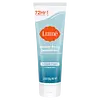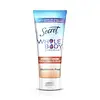What's inside
What's inside
 Key Ingredients
Key Ingredients

 Benefits
Benefits

 Concerns
Concerns

 Ingredients Side-by-side
Ingredients Side-by-side

Water
Skin ConditioningMandelic Acid
AntimicrobialMaranta Arundinacea Root Powder
Skin ConditioningTapioca Starch
Isoamyl Laurate
EmollientHydroxypropyl Starch Phosphate
Cetearyl Alcohol
EmollientCaffeine
Skin ConditioningCaprylic/Capric Triglyceride
MaskingBehenyl Alcohol
EmollientHydrogenated Castor Oil
EmollientAloe Barbadensis Leaf Juice
Skin ConditioningTheobroma Cacao Seed Butter
EmollientTocopherol
AntioxidantAllantoin
Skin ConditioningPanthenol
Skin ConditioningSandalore
Stearyl Alcohol
EmollientDimethicone
EmollientCetearyl Glucoside
EmulsifyingPentylene Glycol
Skin ConditioningPhenylpropanol
MaskingPotassium Hydroxide
BufferingDipropylene Glycol
HumectantSodium Benzoate
MaskingTetrasodium Glutamate Diacetate
Water, Mandelic Acid, Maranta Arundinacea Root Powder, Tapioca Starch, Isoamyl Laurate, Hydroxypropyl Starch Phosphate, Cetearyl Alcohol, Caffeine, Caprylic/Capric Triglyceride, Behenyl Alcohol, Hydrogenated Castor Oil, Aloe Barbadensis Leaf Juice, Theobroma Cacao Seed Butter, Tocopherol, Allantoin, Panthenol, Sandalore, Stearyl Alcohol, Dimethicone, Cetearyl Glucoside, Pentylene Glycol, Phenylpropanol, Potassium Hydroxide, Dipropylene Glycol, Sodium Benzoate, Tetrasodium Glutamate Diacetate
Water
Skin ConditioningGlycerin
HumectantIsohexadecane
EmollientDimethicone
EmollientLactic Acid
BufferingSodium Lactate
BufferingIsopropyl Isostearate
EmollientSodium Polyacryloyldimethyl Taurate
Emulsion StabilisingStearyl Alcohol
EmollientNiacinamide
SmoothingCetyl Alcohol
EmollientPanthenol
Skin ConditioningBehenyl Alcohol
EmollientDimethiconol
EmollientPEG-100 Stearate
Cetearyl Glucoside
EmulsifyingCetearyl Alcohol
EmollientStearic Acid
CleansingSodium Benzoate
MaskingPalmitic Acid
EmollientWater, Glycerin, Isohexadecane, Dimethicone, Lactic Acid, Sodium Lactate, Isopropyl Isostearate, Sodium Polyacryloyldimethyl Taurate, Stearyl Alcohol, Niacinamide, Cetyl Alcohol, Panthenol, Behenyl Alcohol, Dimethiconol, PEG-100 Stearate, Cetearyl Glucoside, Cetearyl Alcohol, Stearic Acid, Sodium Benzoate, Palmitic Acid
 Reviews
Reviews

Ingredients Explained
These ingredients are found in both products.
Ingredients higher up in an ingredient list are typically present in a larger amount.
Behenyl Alcohol is a type of fatty alcohol (these are different from the drying, solvent alcohols).
Fatty Alcohols have hydrating properties and are most often used as an emollient or to thicken a product. They are usually derived from natural fats and oils; behenyl alcohol is derived from the fats of vegetable oils.
Emollients help keep your skin soft and hydrated by creating a film that traps moisture in.
In 2000, Behenyl Alcohol was approved by the US as medicine to reduce the duration of cold sores.
Learn more about Behenyl AlcoholCetearyl alcohol is a mixture of two fatty alcohols: cetyl alcohol and stearyl alcohol. It is mainly used as an emulsifier. Emulsifiers help prevent the separation of oils and products. Due to its composition, it can also be used to thicken a product or help create foam.
Cetearyl alcohol is an emollient. Emollients help soothe and hydrate the skin by trapping moisture.
Studies show Cetearyl alcohol is non-toxic and non-irritating. The FDA allows products labeled "alcohol-free" to have fatty alcohols.
This ingredient is usually derived from plant oils such as palm, vegetable, or coconut oils. There is debate on whether this ingredient will cause acne.
Due to the fatty acid base, this ingredient may not be Malassezia folliculitis safe.
Learn more about Cetearyl AlcoholCetearyl Glucoside is a surfactant and emulsifier. It can be produced from synthetic of natural sources of cetearyl alcohol and glucose.
Emulsifiers help prevent ingredients from separating, such as oils and waters. It can also be used to enhance the texture of products.
As a surfactant, Cetearyl Glucoside helps during the cleansing process. By gathering all the dirt and oils, it allows these molecules to be washed away easily.
Learn more about Cetearyl GlucosideDimethicone is a type of synthetic silicone created from natural materials such as quartz.
What it does:
Dimethicone comes in different viscosities:
Depending on the viscosity, dimethicone has different properties.
Ingredients lists don't always show which type is used, so we recommend reaching out to the brand if you have questions about the viscosity.
This ingredient is unlikely to cause irritation because it does not get absorbed into skin. However, people with silicone allergies should be careful about using this ingredient.
Note: Dimethicone may contribute to pilling. This is because it is not oil or water soluble, so pilling may occur when layered with products. When mixed with heavy oils in a formula, the outcome is also quite greasy.
Learn more about DimethiconePanthenol is a common ingredient that helps hydrate and soothe the skin. It is found naturally in our skin and hair.
There are two forms of panthenol: D and L.
D-panthenol is also known as dexpanthenol. Most cosmetics use dexpanthenol or a mixture of D and L-panthenol.
Panthenol is famous due to its ability to go deeper into the skin's layers. Using this ingredient has numerous pros (and no cons):
Like hyaluronic acid, panthenol is a humectant. Humectants are able to bind and hold large amounts of water to keep skin hydrated.
This ingredient works well for wound healing. It works by increasing tissue in the wound and helps close open wounds.
Once oxidized, panthenol converts to pantothenic acid. Panthothenic acid is found in all living cells.
This ingredient is also referred to as pro-vitamin B5.
Learn more about PanthenolSodium Benzoate is a preservative. It's used in both cosmetic and food products to inhibit the growth of mold and bacteria. It is typically produced synthetically.
Both the US FDA and EU Health Committee have approved the use of sodium benzoate. In the US, levels of 0.1% (of the total product) are allowed.
Sodium benzoate works as a preservative by inhibiting the growth of bacteria inside of cells. It prevents the cell from fermenting a type of sugar using an enzyme called phosphofructokinase.
It is the salt of benzoic acid. Foods containing sodium benzoate include soda, salad dressings, condiments, fruit juices, wines, and snack foods.
Studies for using ascorbic acid and sodium benzoate in cosmetics are lacking, especially in skincare routines with multiple steps.
We always recommend speaking with a professional, such as a dermatologist, if you have any concerns.
Learn more about Sodium BenzoateStearyl Alcohol is a type of fatty alcohol from stearic acid. It is a white, waxy compound used to emulsify ingredients.
Fatty Alcohols are most often used as an emollient or to thicken a product. Emollients help soothe and hydrate the skin by trapping moisture.
They are usually derived from natural fats and oils and therefore do not have the same drying or irritating effect as solvent alcohols. FDA allows products labeled "alcohol-free" to have fatty alcohols.
Learn more about Stearyl AlcoholWater. It's the most common cosmetic ingredient of all. You'll usually see it at the top of ingredient lists, meaning that it makes up the largest part of the product.
So why is it so popular? Water most often acts as a solvent - this means that it helps dissolve other ingredients into the formulation.
You'll also recognize water as that liquid we all need to stay alive. If you see this, drink a glass of water. Stay hydrated!
Learn more about Water